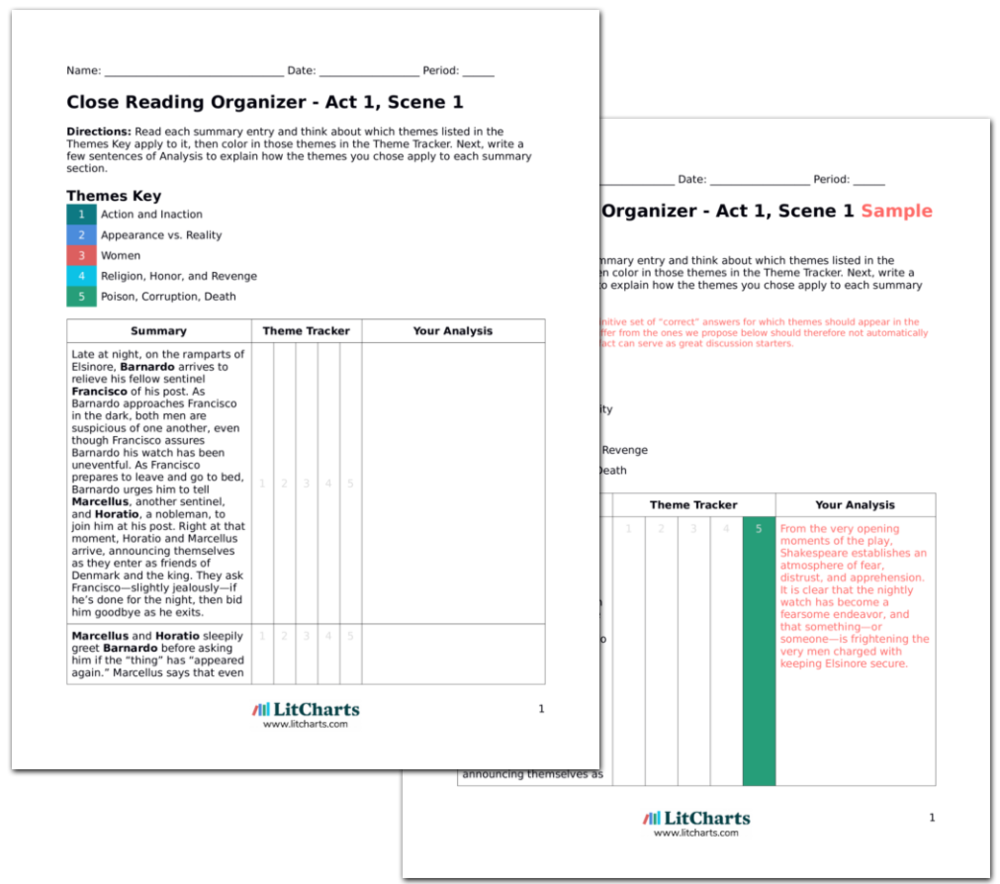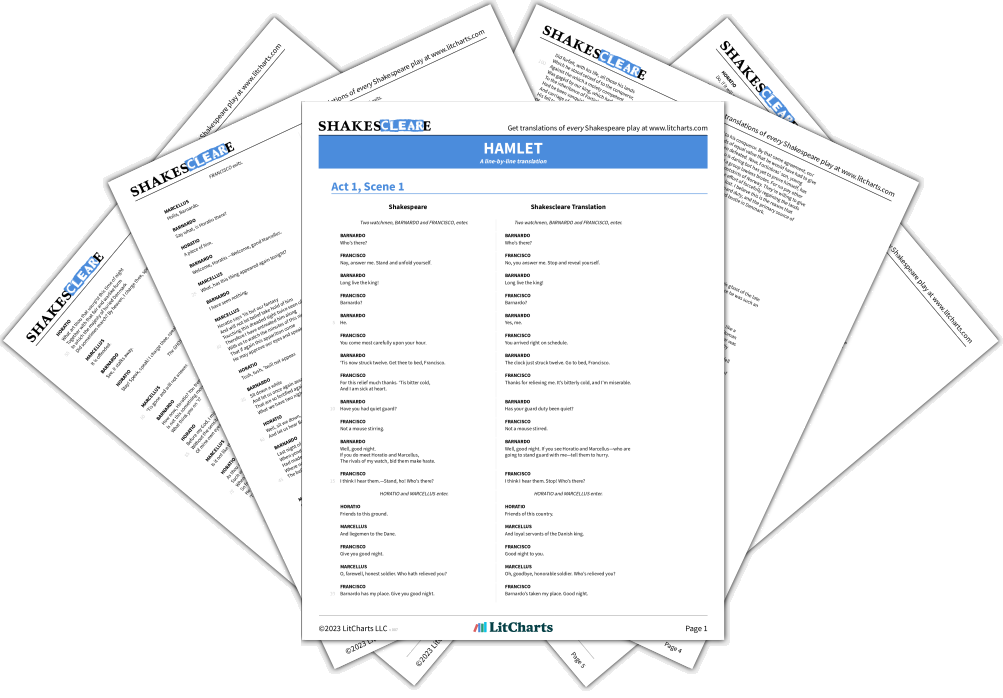![]()
LitCharts assigns a color and icon to each theme in Hamlet, which you can use to track the themes throughout the work.
![]()
![]() Reality Theme Icon" />
Reality Theme Icon" />
![]()
![]()
![]()
Claudius and Laertes discuss Claudius’s innocence in Polonius ’s murder—which Laertes has come to believe. Laertes, however, wants to know why Claudius didn’t pursue vengeance or justice against Polonius’s true murderer, Hamlet . Claudius says there are two reasons he hasn’t killed Hamlet: one being that Gertrude loves him, and the other being that the commoners love him as well. Laertes says that he has no qualms about wounding Hamlet—or his public image—and will soon have revenge.
Claudius admits to being a hypocrite when it comes to Hamlet, and to justice, out of a desire to preserve his own good appearance in the eyes of the public. Laertes claims to have no desire to appear likable—he is one of the few characters in the play who doesn’t seem to be pretending or acting when it comes to the truth of who he is.
Active Themes![]()
![]() Reality Theme Icon" />
Reality Theme Icon" />
![]()
![]()
A messenger enters the hall carrying letters from Hamlet —one for Claudius , and one for the queen. Claudius offers to read them aloud for Laertes . Hamlet’s letter to Claudius reveals that he has been “set naked on [Claudius’s] kingdom”—in other words, he’s returned to Denmark with no money or possessions. Hamlet asks to meet with the king the next day to explain his “sudden and strange return.” Laertes says he’s looking forward to Hamlet’s visit—he wants to look upon the man who killed his father and drove his sister mad.
Hamlet is offering himself up to the king in a vulnerable state, in spite of no doubt having discerned the king’s designs on his life. There is always a scheme going on in this play, and Hamlet clearly has a new one up his sleeve.
Active Themes![]() Reality Theme Icon" />
Reality Theme Icon" />
![]()
Claudius asks Laertes to help him in coming up with a new way to get rid of Hamlet that doesn’t look too suspicious. Laertes says he’ll do whatever Claudius asks, and will even kill Hamlet himself. Claudius agrees that Laertes should be the one to put an end to Hamlet’s life. Claudius reveals that since Laertes left for France, the people of Denmark have been talking about a quality of Laertes’s that makes him “shine.” Laertes asks what quality Claudius speaks of, and Claudius replies that he recently met an acquaintance of Laertes’s who remarked on how excellent the young man was at fencing. Claudius claims that hearing of Laertes’s talent with a rapier “envenom[ed]” Hamlet with jealousy.
Claudius and Laertes’s newest scheme preys upon Hamlet’s own insecurities. They know that Hamlet loves appearing superior and in control, and are planning to extort that weakness in order to get to him.
Active Themes![]()
![]() Reality Theme Icon" />
Reality Theme Icon" />
![]()
Claudius tells Laertes that if he truly still loves his father—and still wants to avenge him—he must “show [him]self in deed [to be his] father’s son,” not just in words. Laertes says he would cut Hamlet’s throat even in the middle of a church.
Laertes is hellbent on revenge—but so far he’s all talk, no action. Whether he is a man of action like Fortinbras or one of inaction, like Hamlet, remains to be seen.
Active Themes![]()
![]()
"My students can't get enough of your charts and their results have gone through the roof." -Graham S.

Claudius tells Laertes that when Hamlet arrives home, Laertes should keep a distance from him rather than jumping straight at him. In the meantime, Claudius will have the people of Elsinore talk up Laertes’s fencing skills so that Hamlet wants to challenge him to a duel. Then, Laertes will be able to pick a rapier with a sharp point and kill Hamlet during the practice duel, making it look like an accident. Laertes agrees to this plan, but wants to take it one step further—he decides to dip the tip of his rapier in poison so that even if Laertes merely scratches Hamlet, the prince will die. Claudius devises a backup plan in which the drinks at the match will be poisoned, so that when Hamlet reaches for a refreshment, he’ll die no matter what the outcome of the duel.
Claudius and Laertes clearly have no qualms at all about killing Hamlet—Laertes says he’d even do the deed in a church, pointing to his positioning of revenge over spirituality or religion, unlike Hamlet himself. Laertes and Claudius want there to be no opportunity for failure, and devise complex actions to ensure that their plan is rock-solid.
Active Themes![]()
![]()
![]()
Gertrude enters and announces that she has even more woeful news: Ophelia has drowned in nearby brook. Her body was found covered in “fantastic garlands” of flowers and cloaked in gorgeous garments, though she died a “muddy death.” Laertes bids Claudius and Gertrude goodbye and goes off to mourn his sister—when he’s finished, he says, he’ll be ready to take his revenge.
The news of Ophelia’s death further inspires Laertes’s fury and desire to kill Hamlet. Whether Ophelia died in an accident or through purposeful suicide is left purposely vague in the play, which raises questions about Hamlet's own musings about suicide earlier in the play as well as his eventual decision to purposefully put himself in harms way to confront Claudius. Further, if Ophelia did die by suicide then even she was more able to take action against her own life than Hamlet, whose endless musings on the value of suicide have led him nowhere. At the same time, Hamlet expressly didn't commit suicide because to do so would be to break the laws of God. Once again the play shows how Hamlet is stymied by identifying conflicting currents of religious, social, and personal goals and values.
Active Themes![]()
![]()
![]()
![]()

“Would not have made it through AP Literature without the printable PDFs. They're like having in-class notes for every discussion!”
Get the Teacher Edition
“This is absolutely THE best teacher resource I have ever purchased. My students love how organized the handouts are and enjoy tracking the themes as a class.”
Hamlet in Plain English
“Every teacher of literature should use these translations. They completely demystify Shakespeare. Students love them!”
Copyright © 2024 All Rights Reserved Save time. Stress less.AI Tools for on-demand study help and teaching prep.
 Quote explanations, with page numbers, for over 44,324 quotes.
Quote explanations, with page numbers, for over 44,324 quotes. PDF downloads of all 2,003 LitCharts guides.
PDF downloads of all 2,003 LitCharts guides. Expert analysis to take your reading to the next level.
Expert analysis to take your reading to the next level. Advanced search to help you find exactly what you're looking for.
Advanced search to help you find exactly what you're looking for.
 Expert analysis to take your reading to the next level.
Expert analysis to take your reading to the next level. Advanced search to help you find exactly what you're looking for.
Advanced search to help you find exactly what you're looking for.